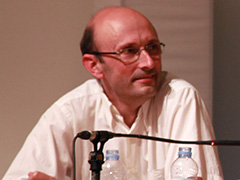Fuses says that, in the twenty-first century, public space is no longer to be found at strictly architectural levels and calls for spaces in which architecture takes on an anonymous quality.
Shared Spaces recorded this conversation with Josep Fuses in May 2012 when he visited the Centre of Contemporary Culture of Barcelona (CCCB) to take part in the launch of Xavier Monteys’ book El plaer de la ciutat (The Pleasure of the City). Fuses believes that “human relations no longer occur in the public spaces that once shaped the city”, for example squares, streets and markets. In the twenty-first century, public space would therefore be found in other levels and strata that are not strictly architectural, for example the Internet or television, which are now more popular.
In this regard, he points out that “squares have lost the real function they once served”. This denatures them and means that they must find new functions, as would be the case with Piazza Navona in Rome, La Rambla in Barcelona, and Place Vendôme in Paris, which have ended up as “tourist attractions and places for visitors and shows”.
In Fuses’ view, “football fields are one of the last architectural public spaces that are still functioning, in the sense that there is consistency between the use people make of them and the form they have, and nobody questions the use to which they are put.” In other words, social consensus over the way they are used endures, while other manifestations in non-architectural public spaces, such as Easter Week processions and royal parades, no longer have this consensus.
Fuses also calls for spaces in which architecture takes on an anonymous quality. Continuing with his example of football stadiums, he says that the rules and regulations of the game determine their interior design so that the architect’s only task is to ensure that every spectator has the best possible view of the match. Accordingly, it is quite difficult to distinguish between them if they are observed only from the inside.
Finally, offering another example of anonymous architecture, he cites the Catalan writer Quim Monzó who says that, “the nicest place and the nicest public space in Catalonia is the promenade of Platja d’Aro in summer because it is a formless street, of no particular kind of architecture but it has people who enjoy being there, shopping, having a drink, strolling around and so on.”



